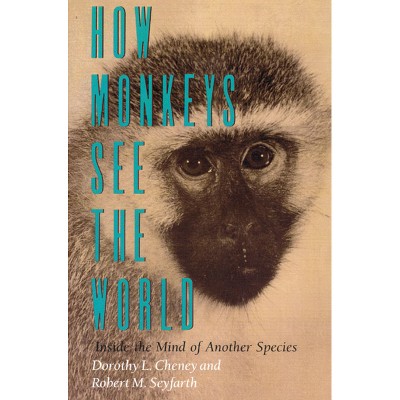Sponsored

Baboon Metaphysics - by Dorothy L Cheney (Paperback)
$22.00
In Stock
Eligible for registries and wish lists
Sponsored
About this item
Highlights
- In 1838 Charles Darwin jotted in a notebook, "He who understands baboon would do more towards metaphysics than Locke.
- About the Author: Dorothy L. Cheney is professor of biology and Robert M. Seyfarth is professor of psychology at the University of Pennsylvania.
- 358 Pages
- Science, Life Sciences
Description
About the Book
Cheney and Seyfarth aim to fully comprehend the intelligence that underlies baboons' social organization. Written with a scientist's precision and a nature-lover's eye, the authors gives readers an unprecedented and compelling glimpse into the mind of another species.Book Synopsis
In 1838 Charles Darwin jotted in a notebook, "He who understands baboon would do more towards metaphysics than Locke." Baboon Metaphysics is Dorothy L. Cheney and Robert M. Seyfarth's fascinating response to Darwin's challenge.Cheney and Seyfarth set up camp in Botswana's Okavango Delta, where they could intimately observe baboons and their social world. Baboons live in groups of up to 150, including a handful of males and eight or nine matrilineal families of females. Such numbers force baboons to form a complicated mix of short-term bonds for mating and longer-term friendships based on careful calculations of status and individual need.
But Baboon Metaphysics is concerned with much more than just baboons' social organization-Cheney and Seyfarth aim to fully comprehend the intelligence that underlies it. Using innovative field experiments, the authors learn that for baboons, just as for humans, family and friends hold the key to mitigating the ill effects of grief, stress, and anxiety.
Written with a scientist's precision and a nature-lover's eye, Baboon Metaphysics gives us an unprecedented and compelling glimpse into the mind of another species.
"The vivid narrative is like a bush detective story."-Steven Poole, Guardian "Baboon Metaphysics is a distillation of a big chunk of academic lives. . . . It is exactly what such a book should be-full of imaginative experiments, meticulous scholarship, limpid literary style, and above all, truly important questions."-Alison Jolly, Science "Cheney and Seyfarth found that for a baboon to get on in life involves a complicated blend of short-term relationships, friendships, and careful status calculations. . . . Needless to say, the ensuing political machinations and convenient romantic dalliances in the quest to become numero uno rival the bard himself."-Science News "Cheney and Seyfarth's enthusiasm is obvious, and their knowledge is vast and expressed with great clarity. All this makes Baboon Metaphysics a captivating read. It will get you thinking-and maybe spur you to travel to Africa to see it all for yourself."-Asif A. Ghazanfar, Nature "Through ingenious playback experiments . . . Cheney and Seyfarth have worked out many aspects of what baboons used their minds for, along with their limitations. Reading a baboon's mind affords an excellent grasp of the dynamics of baboon society. But more than that, it bears on the evolution of the human mind and the nature of human existence."-Nicholas Wade, New York Times
Review Quotes
""Baboon Metaphysics "is a distillation of a big chunk of academic lives: the wife-and-husband team of Dorothy Cheney and Robert Seyfarth plus a flock of their students and friends. It is exactly what such a book should be--full of imaginative experiments, meticulous scholarship, limpid literary style, and above all, truly important questions." -- Alison Jolly "Science"
"As large, dog-snouted animals with ferocious teeth, baboons seem quite distant from us, yet they are genetically quite close to humans. There was even a time when these primates were seen as the best ancestral model for humans. Indeed, using a field technique perfected over the years with vervet monkeys and later with baboons, Cheney and Seyfarth reveal them to be accomplished social schemers. . . . As this lively book illustrates, these monkeys may show limitations in what they understand or care about, but they are absolutely unsurpassed at knowing every little detail of the relationship network of which they are a part." -- Frans de Waal "New Scientist"
"Cheney and Seyfarth found that for a baboon to get on in life involves a complicated blend of short-term relationships, friendships, and careful status calculations; all of which must be weighed up against each baboon''s personal needs and requirements. Needless to say, the ensuing political machinations and convenient romantic dalliances in the quest to become "numero uno" rival the bard himself." Baboon Metaphysics" is a fascinating window on a world seemingly parallel to our own, while examining why science still considers the human brain unique."--"Science News"
"Lovers'' quarrels and murder, greed and social climbing: baboon society has all the features that make a mainstream novel a page-turner. The question Cheney and Seyfarth ask, however, is more demanding: how much of baboon behavior is instinctive, and how much comes from actual thought? Are baboons self-aware? To find answers, the authors spent years observing a clan of baboons in Botswana''s Moremi Game Reserve. Like most primates, baboons are social creatures, living in large groups of 100, where individual rank--and the ability to claim food or a mate--is based on a complex web of birth and consort relationships. Cheney and Seyfarth pepper their descriptions with surprisingly apt literary comparisons, such as the example of a baboon who runs afoul of a higher-ranking member and receives much the same treatment as an unwitting character in an Edith Wharton novel. Along the way we get a good look at the state of current primate research on intelligence and learn why scientists think the human brain is still unique. While describing important research about baboon cognition and social relations, this book charms as much as it informs."--Publishers Weekly
"The vivid narrative is like a bush detective story. . . and the authors'' conclusions have intriguing implications for the evolution of language in humans." -- Steven Poole "Guardian"
Pursuing the understanding and existence of knowledge (metaphysics) in the best tradition of Darwinian naturalists with a philosophical interest, Cheney and Seyfarth probe the depth of baboon and other caterrhine primate social behavior that is the central context of the evolution of minds of social primates, including humans. In this engaging, thoughtful work, the authors range widely and plumb topics deeply. . . . Their dedication to field observations of baboons and other primates for decades, coupled with field experiments, renders this work unique. The book is a sagacious milestone that deserves the close attention not only of biologists and primatologists, but also of psychologists and social scientists.
0;"Baboon Metaphysics "is a distillation of a big chunk of academic lives: the wife-and-husband team of Dorothy Cheney and Robert Seyfarth plus a flock of their students and friends. It is exactly what such a book should be2;full of imaginative experiments, meticulous scholarship, limpid literary style, and above all, truly important questions.1;2;Alison Jolly, "Science" -- Alison Jolly "Science"
0;In one of his notebooks, Charles Darwin wrote, 6;Origin of man proved.2;Metaphysic must flourish.--he who understands baboon would do more towards metaphysics than Locke.7; Robert M. Seyfarth and Dorothy L. Cheney--pioneers in the study of primate psychology2;take up the challenge. . . . Any way you look at it, the authors say, most of the problems facing baboons can be expressed in two words: other baboons. The authors aim to understand the intelligence that underlies this social organization.1;2;"Scientific American"
0; "Baboon Metaphysics "is a distillation of a big chunk of academic lives: the wife-and-husband team of Dorothy Cheney and Robert Seyfarth plus a flock of their students and friends. It is exactly what such a book should be2;full of imaginative experiments, meticulous scholarship, limpid literary style, and above all, truly important questions.1;2; Alison Jolly, "Science" -- Alison Jolly "Science"
"Cheney and Seyfarth have produced a book that should be on the reading list of every scientist, student, and lay reader who searches for a seasoned, documented, and highly interesting thesis of what they have learned during decades of well-planned and executed research about the mind, thought, and intelligence of baboons."
0;Darwin, a witness to the stereotyped behaviours of numerous animals, could not abide Locke7;s view and sought an explanation of the mind that combined the roles of innate tendencies and experience. This tension pervades this wonderful book on the social intelligence of non-human primates and what they might tell us about the evolution of the human mind. Few are in a better position to address the question than Cheney and Seyfarth. . . . Their enthusiasm is obvious, and their knowledge is vast and expressed with great clarity. All this makes "Baboon Metaphysics" a captivating read. It will get you thinking--and maybe spur you to travel to Africa to see it all for yourself .1;2;Asif A. Ghazanfar, "Nature"
"Accessible enough for most general readers, ''Baboon Metaphysics'' does not assume prior knowledge of baboons, biology, or philosophy. Anyone dedicated enough can pick it up and digest its fascinating contents . . . [and] anyone seeking appreciation of the complexities of both animal and human life will find it here." -- T.B. Robbins "Reviewer's Bookwatch"
"Darwin, a witness to the stereotyped behaviours of numerous animals, could not abide Locke's view and sought an explanation of the mind that combined the roles of innate tendencies and experience. This tension pervades this wonderful book on the social intelligence of non-human primates and what they might tell us about the evolution of the human mind. Few are in a better position to address the question than Cheney and Seyfarth. . . . Their enthusiasm is obvious, and their knowledge is vast and expressed with great clarity. All this makes "Baboon Metaphysics" a captivating read. It will get you thinking--and maybe spur you to travel to Africa to see it all for yourself."--Asif A. Ghazanfar, "Nature"
"In one of his notebooks, Charles Darwin wrote, 'Origin of man proved.--Metaphysic must flourish.--he who understands baboon would do more towards metaphysics than Locke.' Robert M. Seyfarth and Dorothy L. Cheney--pioneers in the study of primate psychology--take up the challenge. . . . Any way you look at it, the authors say, most of the problems facing baboons can be expressed in two words: other baboons. The authors aim to understand the intelligence that underlies this social organization."--"Scientific American"
"Lovers' quarrels and murder, greed and social climbing: baboon society has all the features that make a mainstream novel a page-turner. The question Cheney and Seyfarth ask, however, is more demanding: how much of baboon behavior is instinctive, and how much comes from actual thought? Are baboons self-aware? . . . While describing important research about baboon cognition and social relations, this book charms as much as it informs."--"Publishers Weekly"
About the Author
Dorothy L. Cheney is professor of biology and Robert M. Seyfarth is professor of psychology at the University of Pennsylvania. They are the authors of How Monkeys See the World, also published by the University of Chicago Press.Dimensions (Overall): 8.96 Inches (H) x 6.34 Inches (W) x .75 Inches (D)
Weight: 1.09 Pounds
Suggested Age: 22 Years and Up
Number of Pages: 358
Genre: Science
Sub-Genre: Life Sciences
Publisher: University of Chicago Press
Theme: Zoology, Primatology
Format: Paperback
Author: Dorothy L Cheney
Language: English
Street Date: September 1, 2008
TCIN: 1006091627
UPC: 9780226102443
Item Number (DPCI): 247-23-5367
Origin: Made in the USA or Imported
If the item details aren’t accurate or complete, we want to know about it.
Shipping details
Estimated ship dimensions: 0.75 inches length x 6.34 inches width x 8.96 inches height
Estimated ship weight: 1.09 pounds
We regret that this item cannot be shipped to PO Boxes.
This item cannot be shipped to the following locations: American Samoa (see also separate entry under AS), Guam (see also separate entry under GU), Northern Mariana Islands, Puerto Rico (see also separate entry under PR), United States Minor Outlying Islands, Virgin Islands, U.S., APO/FPO
Return details
This item can be returned to any Target store or Target.com.
This item must be returned within 90 days of the date it was purchased in store, shipped, delivered by a Shipt shopper, or made ready for pickup.
See the return policy for complete information.
Frequently bought together

$8.49
MSRP $14.99
Buy 1, get 1 50% off select books
2 out of 5 stars with 1 ratings
Trending Non-Fiction

$15.68
Buy 1, get 1 50% off select books
4.8 out of 5 stars with 208 ratings

Highly rated
$19.31
was $20.98 New lower price
Buy 1, get 1 50% off select books
3.9 out of 5 stars with 71 ratings

$18.28
was $19.58 New lower price
Buy 1, get 1 50% off select books
4.7 out of 5 stars with 17 ratings

$4.59
MSRP $7.99
Buy 1, get 1 50% off select books
4.8 out of 5 stars with 125 ratings

$6.20
MSRP $10.95
Buy 1, get 1 50% off select books
4.8 out of 5 stars with 33 ratings

$7.09
MSRP $9.99
Buy 1, get 1 50% off select books
4.9 out of 5 stars with 46 ratings










